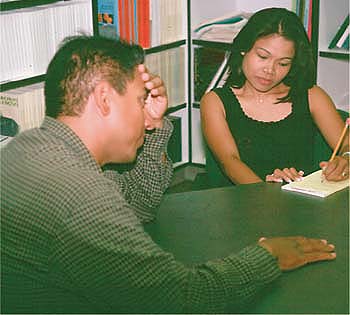All Issues
“Pre-caucusing” improves labor mediation
Publication Information
California Agriculture 58(1):8-9.
Published January 01, 2004
PDF | Citation | Permissions
Full text
The manager of the agricultural firm was highly valued by his company. But quite often, he lost patience with one of his employees, getting extremely angry, yelling and swearing. The workplace had become an intolerable place for both employees.
When the two men were referred for mediation to Gregorio Billikopf Encina, he was not at all confident that “we could bring these two people together.”
But Billikopf, a UC labor management farm advisor since 1981, employed a deceptively simple technique that he developed and honed over the years as a mediator and an equal employment opportunity counselor for UC. Before the two men were scheduled for a joint session, he met with each of them separately, several times, for numerous hours. He listened to their concerns and allowed each to fully express his feelings, then coached them — via role-playing and other techniques — to present their issues in a nonconfrontational way and to negotiate constructively.
The resulting joint session surprised and stunned even Billikopf. The two men were exceedingly polite and friendly toward each other, chatting so amiably and quickly that Billikopf had trouble keeping up with their agreements. “During the pre-caucus the angry manager gave a lame apology about his anger and swearing,” Billikopf says. “But his apology in the joint session was sincere and effective.”
“Pre-caucusing,” when each party meets separately with the mediator before the joint session, is a critical component of Billikopf's mediation model. (“Caucusing” refers to side meetings between one of the parties and the mediator.) “This is probably the most important contribution I have made during my 20 years in extension,” says Billikopf, who is based in Modesto and serves San Joaquin, Stanislaus and Merced counties.
Traditional mediation is “directive,” meaning that the mediator's role is to guide both sides toward a solution. By contrast, in arbitration the third party suggests or enforces solutions. Mediators bring the stakeholders together and ask each to present his or her case while the other listens. However, Billikopf says traditional mediation sessions often deteriorate, with each side interrupting the other and getting progressively more angry. Furthermore, the mediator may often become heavy-handed and take on the role of an arbitrator.
Some mediators feel that loss of control is unavoidable, part of the process, or even necessary. Most third-party neutrals, however, would probably welcome an approach where such dysfunctional escalations were either greatly reduced or completely eliminated.
Pre-caucusing reinforces an alternative mode of mediation called “transformative,” first described in the mid-1990s, in which the mediator's role recedes. Billikopf says he has taken the nondirective approach further, with the parties facing and talking to each other directly during the joint session.
“Because stakeholders address each other rather than the mediator, there is little chance for the mediator to abuse his or her power,” he says. “And as a result of the pre-caucusing, the stakeholders are better prepared to face their contender and negotiate a solution on their own rather than having one suggested or imposed by the mediator.”
Often, the most important function of the pre-caucus is figuring out ways for each side to express pent-up feelings. “It takes courage for people who have been fighting for years to tell the other person how hurt they are,” Billikopf says.
The main concerns expressed by critics of pre-caucusing are that stakeholders may attempt to influence the mediator to take his or her side during the pre-caucus, and that the mediator may become biased.
Billikopf responds to these concerns in an article on pre-caucusing published in the journal Group Facilitation (Spring 2002). He also incorporated information on pre-caucusing into the second edition of his book, Labor Management in Agriculture: Cultivating Personnel Productivity, published by the UC Agricultural Issues Center in English and Spanish in mid-2003.
Pre-caucusing is slowly being adopted not only in agriculture and the workplace, but also in other settings where mediators solve interpersonal conflicts such as women's shelters, churches and community mediation centers, as well as by attorneys and professors of conflict management and organizational behavior.
“It also helps facilitators understand factors that affect the likelihood of success,” Billikopf says, “so a more informed decision can be made as to whether to bring both parties into a joint session.”
Billikopf says his experiences in recent years with pre-caucusing have caused him to reevaluate his initial forays into mediating labor disputes, where he had not sufficiently understood the potential of the pre-caucus. “I wish I knew then, what I know now.”
For more information, go to: www.cnr.berkeley.edu/ucce50/ag-labor/ .






